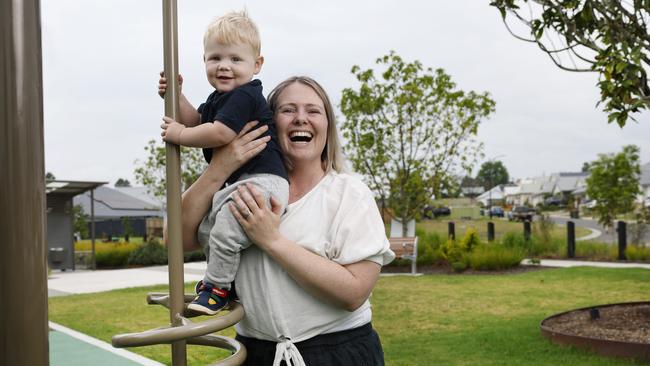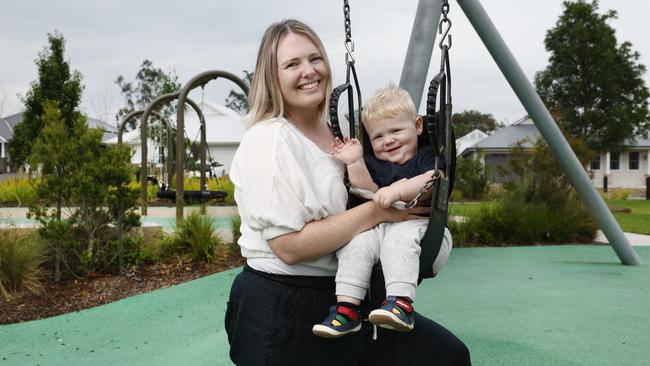Sydney suburbs where people are having the most babies
A new analysis has exposed a big shift Sydney families are making, revealing which suburbs are having the most babies and whats driving the change.

Soaring living costs have created a demographic shift, where natural population growth is being driven by births in outer-city suburbs, as growing families take advantage of cheaper housing options.
A new KPMG analysis of ABS data has revealed where households are having the most babies, showing those living on the outskirts of the city were having more kids, while birthrates in pricier inner- and middle-ring suburbs tended to be lower.
KPMG urban economist Terry Rawley said families were larger in areas with significant housing development and open space because the costs were cheaper.
“Housing in these areas are largely affordable and well-suited for families,” Mr Rawley said.
The analysis revealed NSW had 91,509 births in 2023, suburbs with the highest birthrates
tended to offer families a diverse range of affordable housing including new apartments and houses on larger blocks.
MORE: Radical $2bn skyscraper smashes city records

Western suburbs Schofields, Oran Park, Merrylands, Holroyd and Marsden Park were the areas with the highest birthrates, according to the KPMG analysis of 2023 births, ranging from 445-563 births in each suburb.
High-rise apartment precincts Wentworth Point and Sydney Olympic Park, some of the cheapest unit markets within 20km of the CBD, also had higher birthrates, with 407 births in the year.
“There is a strong increase in families embracing apartment living, a trend that is likely to continue in the future,” Mr Rawley said.
MORE: Sydney home prices to plummet in 2025
Demographer Simon Kuestenmacher said cost of living pressures were hitting families or areas with higher birthrates the hardest.
“The housing element is very expensive, if you have no kids you don’t have to spend as much on housing, because a smaller dwelling will do,” he said.

MORE: Huge prediction for Aussie house prices
The demographer said Australians are willing to compromise on location and type of home, but not the number of bedrooms.
“They (Australians) have the logic that you have one for the parents and one for each kid, and if you have a knowledge based job you need a small study too, so you will go where you can afford the four-bedroom homes.”
Birthrates were closely tied to the cost of living and people’s economic prospects, Mr Kuestenmacher said.
“In order to drive up the birthrates, young people need to be optimistic of their future finances and of the broader economic system,” he said.
Tightening household budgets and downsizer trends were behind the lower birthrates in many other areas, Mr Kuestenmacher added.

“I always joke that the main goal of an Australian is to be carried out of your house,” he said. “So in former family suburbs, their birthrates begin to drop and the death rates go up as the young parents of yesteryear stay in the family home.”
Some of the areas with the lowest recorded births were middle-ring suburbs like Belrose, Hunters Hill, and Woolwich. These areas tended to be pricier and had limited housing development.
Areas like Castle Hill (East), Erina and Green Point had even lower birthrates but this was more the result of a higher concentration of aged care facilities in those locations.
Outside of Sydney, areas like Port Macquarie and Coffs Harbour where people retired 20 years ago also now have a greater share of elderly residents and some of the lowest birthrates across the state, according to KPMG.
Cassandra Stewart and her husband Matthew have owned a home in Oran Park for nine years, and recently purchased a block of land at Mirvac’s The Village in Menangle, 10 minutes from their current home.

They welcomed their son Max in May last year, which encouraged the couple to want more space in a quieter estate and to build their “forever family home”.
“People think we are crazy for leaving Oran Park, its got nice schools, a pool … but we wanted a bigger block in a smaller estate that was quieter and had the community feel where you get to know your neighbours,” Ms Stewart said.
Their land at The Village cost $680,000 for a 510 sqm block and they were building a double storey four-bedroom house with a granny flat for $730,000.

“There is a new land release in Oran Park, but it was the difference of about $200,000, the price of living is exorbitant, we wouldn’t be able to build what we wanted and this is only an extra 10 minutes away” she said.
“We wanted an estate that was close to amenities, its near Camden airport for my husband’s work and where we could have a wider block that we could also fit a granny flat for my Dad,” she said.
“Max is our beautiful IVF baby, we are so lucky and that’s why we want to build our dream home … we want to give him everything.”
Originally published as Sydney suburbs where people are having the most babies
